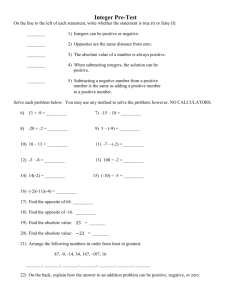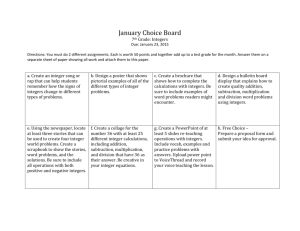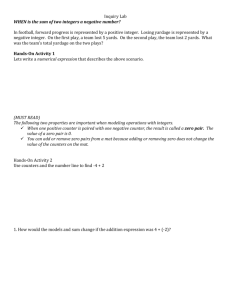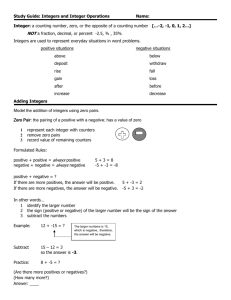25 Integers: Addition and Subtraction
advertisement
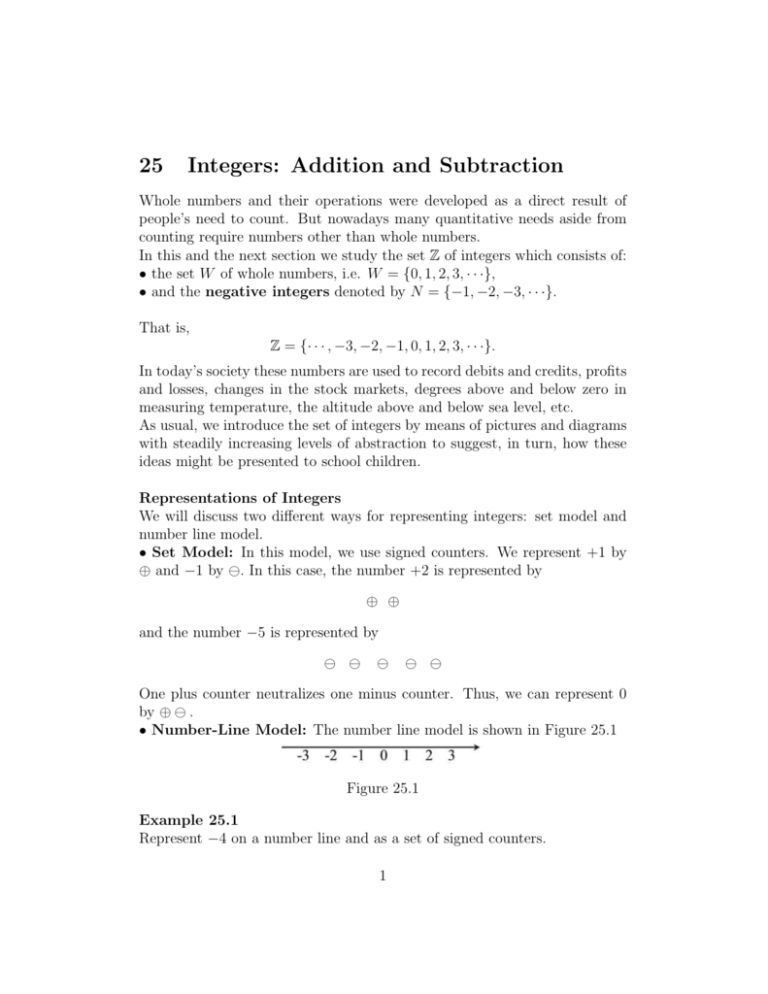
25
Integers: Addition and Subtraction
Whole numbers and their operations were developed as a direct result of
people’s need to count. But nowadays many quantitative needs aside from
counting require numbers other than whole numbers.
In this and the next section we study the set Z of integers which consists of:
• the set W of whole numbers, i.e. W = {0, 1, 2, 3, · · ·},
• and the negative integers denoted by N = {−1, −2, −3, · · ·}.
That is,
Z = {· · · , −3, −2, −1, 0, 1, 2, 3, · · ·}.
In today’s society these numbers are used to record debits and credits, profits
and losses, changes in the stock markets, degrees above and below zero in
measuring temperature, the altitude above and below sea level, etc.
As usual, we introduce the set of integers by means of pictures and diagrams
with steadily increasing levels of abstraction to suggest, in turn, how these
ideas might be presented to school children.
Representations of Integers
We will discuss two different ways for representing integers: set model and
number line model.
• Set Model: In this model, we use signed counters. We represent +1 by
⊕ and −1 by . In this case, the number +2 is represented by
⊕ ⊕
and the number −5 is represented by
One plus counter neutralizes one minus counter. Thus, we can represent 0
by ⊕ .
• Number-Line Model: The number line model is shown in Figure 25.1
Figure 25.1
Example 25.1
Represent −4 on a number line and as a set of signed counters.
1
Solution.
Using signed counters we have
Figure 25.2 shows the position of −4 on a number-line.
Figure 25.2
Looking at Figure 25.1, we see that −2 and 2 have the same distance from
0 but on opposite sides. Such numbers are called opposite. In general, the
opposite of x is −x. Hence, the opposite of 5 is −5 and the opposite of −5 is
−(−5) = 5.
Example 25.2
Find the opposite of each of these integers.
(a) 4 (b) −2 (c) 0
Solution.
(a) The opposite of 4 is −4.
(b) The opposite of −2 is −(−2) = 2.
(c) The opposite of 0 is 0 since 0 is neither positive nor negative.
Absolute Value of an Integer
As an important application of the use of the number line model for integers
is the concept of absolute value of an integer. We see from Figure 25.1 that
the number −3 is represented by the point numbered −3 and the integer 3
is represented by the point numbered 3. Note that both −3 and 3 are three
units from 0 on the number line. The absolute value of an integer x is
the distance of the corresponding point on the number line from zero. We
indicate the absolute value of x by |x|. It follows from the above discussion
that | − 3| = |3| = 3.
Example 25.3
Determine the absolute values of these integers.
(a) −11 (b) 11 (c) 0
2
Solution.
(a) | − 11| = 11 (b) |11| = 11 (c) |0| = 0.
Practice Problems
Problem 25.1
Which of the following are integers?
(a) −11 (b) 0 (c) 34 (d) −9
3
Problem 25.2
Let N = {−1, −2, −3, · · ·}. Find
(a) N ∪ W
(b) N ∩ N, where N is the set of natural numbers or positive integers and W
is the set of whole numbers.
Problem 25.3
What number is 5 units to the left of −95?
Problem 25.4
A and B are 9 units apart on the number line. A is twice as far from 0 as
B. What are A and B?
Problem 25.5
Represent −5 using signed counters and number line.
Problem 25.6
In terms of distance, explain why | − 4| = 4.
Problem 25.7
Find the additive inverse (i.e. opposite) of each of the following integers.
(a) 2 (b) 0 (c) −5 (d) m (e) −m
Problem 25.8
Evaluate each of the following.
(a) | − 5| (b) |10| (c) −| − 4| (d) −|5|
Problem 25.9
Find all possible integers x such that |x| = 2.
3
Problem 25.10
Let W be the set of whole numbers, Z+ the set of positive integers (i.e.
Z+ = N), Z− the set of negative integers, and Z the set of all integers. Find
each of the following.
(a) W ∪ Z (b) W ∩ Z (c) Z+ ∪ Z− (d) Z+ ∩ Z− (e) W − Z+
In the remainder of this section we discuss integer addition and subtraction.
We will use the devices of signed counters and number lines to illustrate how
these operations should be performed in the set of integers.
Addition of Integers
A football player loses 3 yards on one play and 2 yards on the next, what’s
the player’s overall yardage on the two plays? The answer is −3+(−2) which
involves addition of integers. We compute this sum using the two models discussed above.
• Using Signed Counters
Since −3 is represented by 3 negative counters and −2 is represented by 2
negative counters then by combining these counters we obtain 5 negative
counters which represent the integer −5. So −3 + (−2) = −5.
• Using Number Line
Move three units to the left of 0 and then 2 units to the left from −3 as
shown in Figure 25.3.
Figure 25.3
Example 25.4
Find the following sums using (i) signed counters, and (ii) number line.
(a) (−7) + 4 (b) 5 + (−2) (c) 2 + (−2)
4
Solution.
The results of the above examples are entirely typical and we state them
as a theorem.
Theorem 25.1
Let a and b be integers. Then the following are always true:
(i) (−a) + (−b) = −(a + b)
(ii) If a > b then a + (−b) = a − b
(iii) If a < b then a + (−b) = −(b − a)
(iv) a + (−a) = 0.
Example 25.5
Compute the following sums.
(a) 7 + 11 (b) (−6) + (−5) (c) 7 + (−3) (d) 4 + (−9) (e) 6 + (−6)
Solution.
(a) 7 + 11 = 18
(b) (−6) + (−5) = −(6 + 5) = −11
(c) 7 + (−3) = 7 − 3 = 4
(d) 4 + (−9) = −(9 − 4) = −5
(e) 6 + (−6) = 0
Integer addition has all the properties of whole number addition. These
properties are summarized in the following theorem.
5
Theorem 25.2
Let a, b, and c be integers.
Closure a + b is a unique integer.
Commutativity a + b = b + a.
Associativity a + (b + c) = (a + b) + c.
Identity Element 0 is the unique integer such that a + 0 = 0 + a = a.
A useful consequence of Theorem 25.1 (iv) is the additive cancellation.
Theorem 25.3
For any integers a, b, c, if a + c = b + c then a = b.
Proof.
a =
a+0
identity element
= a + (c + (−c)) additive inverse
= (a + c) + (−c)
associativity
=
(b + c) + c
given
= b + (c + (−c))
associativity
=
b+0
additive inverse
=
b
identity element
Example 25.6
Use the additive cancellation to show that −(−a) = a.
Solution.
Since a + (−a) = (−(−a)) + (−a) = 0 then by the additive cancellation
property we have a = −(−a)
Practice Problems
Problem 25.11
What is the opposite or additive inverse of each of the following? (a and b
are integers)
(a) a + b (b) a − b
Problem 25.12
What integer addition problem is shown on the number line?
6
Problem 25.13
(a) Explain how to compute −7 + 2 with a number line.
(b) Explain how to compute −7 + 2 with signed counters.
Problem 25.14
In today’s mail, you will receive a check for $86, a bill for $30, and another
bill for $20. Write an integer addition equation that gives the overall gain or
loss.
Problem 25.15
Compute the following without a calculator.
(a) −54 + 25 (b) (−8) + (−17) (c) 400 + (−35)
Problem 25.16
Show two ways to represent the integer 3 using signed counters.
Problem 25.17
Illustrate each of the following addition using the signed counters.
(a) 5 + (−3) (b) −2 + 3 (c) −3 + 2 (d) (−3) + (−2)
Problem 25.18
Demonstrate each of the additions in the previous problem using number line
model.
Problem 25.19
Write an addition problem that corresponds to each of the following sentences
and then answer the question.
(a) The temperature was −10◦ C and then it rose by 8◦ C. What is the new
temperature?
(b) A certain stock dropped 17 points and the following day gained 10 points.
What was the net change in the stock’s worth?
(c) A visitor to a casino lost $200, won $100, and then lost $50. What is the
change in the gambler’s net worth?
Problem 25.20
Compute each of the following: (a) |(−9) + (−5)|
|(−7) + 6|
7
(b) |7 + (−5)|
(c)
Problem 25.21
If a is an element of {−3, −2, −1, 0, 1, 2} and b is an element of {−5, −4, −3, −2, −1, 0, 1},
find the smallest and largest values for the following expressions.
(a) a + b (b) |a + b|
Subtraction of Integers
Like integer addition, integer subtraction can be illustrated with signed counters and number line.
• Signed Counters
Take Away Approach
As with the subtraction of whole numbers, one approach to integer subtraction is the notion of ”take away.” Figure 25.4 illustrates various examples of
subtraction of integers.
Figure 25.4
Another important fact about subtraction of integers is illustrated in Figure
25.5.
Figure 25.5
8
Note that 5 − 3 = 5 + (−3). In general, the following is true.
Adding the Opposite Approach
For all integers a and b, a − b = a + (−b).
Adding the opposite is perhaps the most efficient method for subtracting
integers because it replaces any subtraction problem with an equivalent addition problem.
Example 25.7
Find the following differences by adding the opposite.
(a) −8 − 3 (b) 4 − (−5)
Solution.
(a) −8 − 3 = (−8) + (−3) = −(8 + 3) = −11.
(b) 4 − (−5) = 4 + [−(−5)] = 4 + 5 = 9.
Missing-Addend Approach
Signed counters model can be also used to illustrate the ”missing-addend”
approach for the subtraction of integers. Figure 25.6 illustrates both equations 3 − (−2) = 5 and 3 = 5 + (−2).
Figure 25.6
Since all subtraction diagrams can be interpreted in this way, we can introduce the ”missing-addend” approach for subtraction:
If a, b, and c are any integers, then a − b = c if and only if a = c + b.
• Number Line Model
The number line model used for integer addition can also be used to model
integer subtraction. In this model, the operation of subtraction corresponds
of starting from the tail of the first number facing the negative direction.
9
Thus, from the tail of the first number we move forward if we are subtracting a positive integer and backward if we are subtracting a negative integer.
Figure 25.7 illustrates some examples.
Figure 25.7
In summary there are three equivalent ways to view subtraction of integers.
1. Take away
2. Adding the opposite
3. Missing addend
Example 25.8
Find 4 − (−2) using all three methods of subtraction.
Solution.
Take away: See Figure 25.8
Figure 25.8
Adding the opposite: 4 − (−2) = 4 + [−(−2)] = 4 + 2 = 6.
Missing-Addend: 4 − (−2) = c if and only if 4 = c + (−2). But 4 = 6 + (−2)
so that c = 6.
Practice Problems
10
Problem 25.22
Explain how to compute 5 − (−2) using a number line.
Problem 25.23
Tell what subtraction problem each picture illustrates.
Problem 25.24
Explain how to compute the following with signed counters.
(a) (−6) − (−2) (b) 2 − 6 (c) −2 − 3 (d) 2 − (−4)
Problem 25.25
(a) On a number line, subtracting 3 is the same as moving
.
the
(b) On a number line, adding −3 is the same as moving
.
units to
units to the
Problem 25.26
An elevetor is at an altitude of −10 feet. The elevator goes down 30 ft.
(a) Write an integer equation for this situation.
(b) What is the new altitude?
Problem 25.27
Compute each of the following using a − b = a + (−b).
(a) 3 − (−2) (b) −3 − 2 (c) −3 − (−2)
Problem 25.28
Use number-line model to find the following.
(a) −4 − (−1) (b) −2 − 1.
11
Problem 25.29
Compute each of the following.
(a) |5 − 11| (b) |(−4) − (−10)| (c) |8 − (−3)| (d) |(−8) − 2|
Problem 25.30
Find x.
(a) x + 21 = 16 (b) (−5) + x = 7 (c) x − 6 = −5 (d) x − (−8) = 17.
Problem 25.31
Which of the following properties hold for integer subtraction. If a property
does not hold, disprove it by a counterexample.
(a) Closure (b) Commutative (c) Associative (d) Identity
12


